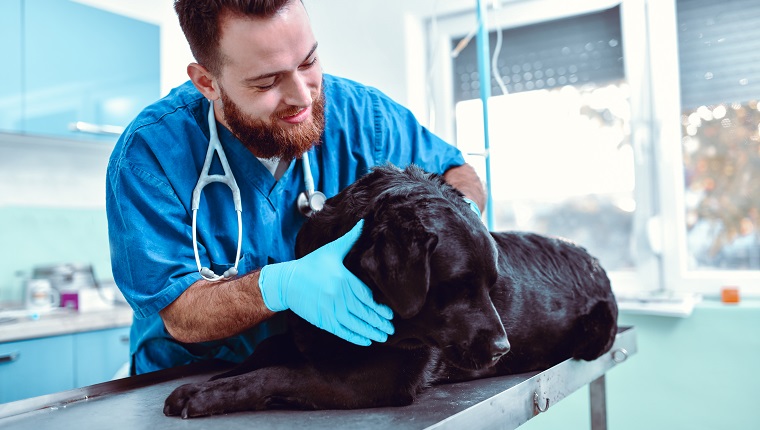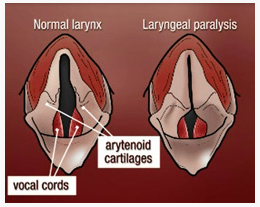
The toughest decision for a pet owner is that of euthanizing their beloved four-legged friend. Dogs, as they age, suffer from various health conditions, some of which affect them so severely that their quality of life degrades to a great extent. Laryngeal paralysis in dogs is one such serious condition.

One such serious medical condition affecting dogs is laryngeal paralysis. It is a progressive disease that, if left untreated, can result in life-threatening effects that are hard to deal with.
In this post, let us try to understand what dog owners can expect with laryngeal paralysis, the best treatment options available, and when they should decide to euthanize their furry friends dealing with this condition.
Laryngeal Paralysis In Dogs – When To Euthanize?
Laryngeal paralysis mostly affects senior dogs and those belonging to giant breeds like Golden Retrievers and Labradors. It can exist from birth, occur as a degenerative disorder with age, or from a trauma or throat injury.
This condition is associated with the larynx, reducing its expanding capacity so that the dog faces difficulty breathing deeply.
As it causes breathing difficulty and suffocation, the condition is quite stressful for the dog suffering from it. The affected pet exhibits symptoms like:
- noisy breathing
- panting without any strain
- getting tired quickly during walks
You can notice a change in the pet’s voice and even hoarseness. The condition also causes other problems like coughing and gagging, especially after the intake of food and drinks.
While it is easy to treat mild cases of laryngeal paralysis with antibiotics, sedatives, and anti-inflammatory drugs, more serious conditions may require surgical treatments to ease the symptoms.
Pet owners may decide to euthanize the dog if it is too old to undergo surgery and is dealing with symptoms that make daily activities difficult.
GOLPP Progression & When To Euthanize A GOLPP Dog?
Laryngeal paralysis can often affect a dog as a part of a disorder of the nervous system called GOLPP (Geriatric Onset Laryngeal Paralysis and Polyneuropathy).
This problem is commonly seen in older, big, giant-breed dogs and is progressive in nature. It causes paralysis of the hind limbs, esophagus, and larynx. Symptoms worsen with time and there is no cure for the condition.
With GOLPP progression, the dog exhibits instability and weakness of the hind limbs. It gradually loses its muscle mass, finds difficulty jumping and climbing, and experiences imbalance at its back.

If the affected pooch is too old or has a rapidly progressing condition, it may not respond to these treatments in which case owners may decide to put it down. One should, however, visit the vet and discuss the dog’s condition, symptoms, quality of life, and available options before deciding to euthanize it.
End Stage Laryngeal Paralysis – What To Expect?
Laryngeal paralysis shows varying signs and symptoms, making it difficult to diagnose it in its initial stages.
This condition affects middle-aged to elderly dogs and the early signs include:
- noisy breathing
- cough
- breath shortness
which often go unnoticed until the disease progresses into later stages.
Most aged dogs cough and make noise while breathing after a strenuous activity which is why it becomes hard to diagnose laryngeal paralysis early enough.

If diagnosed in its early stages, laryngeal paralysis can be controlled and treated with the help of medicines, lifestyle changes, and environmental modifications.
However, it can progress quickly to its end stage where the pet can suffer from respiratory collapse or even sudden death. This condition progresses to damage nerves of other organs, making it difficult to perform everyday functions like eating.
In the later stages, you can expect the dog to develop a respiratory crisis where it gets anxious from being unable to breathe. Also, swelling of the laryngeal folds and worsening obstruction leads to overheating and other troubles.
The foods and fluids fed to the dog can get into its lungs. It is important to provide emergency care in such a situation with the help of the best surgical treatment available.
Your vet may advise a ‘tie-back’ procedure in severe cases of laryngeal paralysis to open up the larynx to facilitate increased airflow. The surgical procedure is known to deliver immediate relief to the pet.
Another serious complication reported in the end stages of laryngeal paralysis is aspiration pneumonia resulting from water, saliva, food, and vomit inhaled into the lungs.
Such a condition demands fluid therapy, hospitalization, antibiotics, nebulization, and other instant treatment plans to ease the pet.
Canine Laryngeal Paralysis Non-Surgical Treatment – A Complete Guide
Canine laryngeal paralysis generally causes degeneration of nerves that cannot be prevented or reversed with the help of medication.
The treatment plan for this condition often involves slowing down the progression and improving the symptoms to help the pet maintain its quality of life.
One of the most effective ways to improve the symptoms of laryngeal paralysis is through environmental modification. Dog owners should make changes to avoid any situation that could make it difficult for the dog to breathe.
Any strenuous activity, exercise, playtime as well as exciting situations should be avoided. It is better to take the pet for slow walks and avoid taking them out in hot and humid climatic conditions.
A pet with low levels of thyroid can be treated with supplements to ease the symptoms and eliminate the need for surgery. Another consideration is to focus on the dog’s weight and nutrition.
An overweight pup may find it more difficult to breathe when suffering from laryngeal paralysis, so it helps to lose some weight. In case of limb weakness and instability, a therapy like an underwater treadmill should help regain balance and strength.
Dysfunction of the esophagus is a common problem associated with laryngeal paralysis. This condition can be identified by symptoms like excessive licking, drooling, and swallowing.
It can be treated with the help of a non-surgical treatment that involves helping the pet pass food and water quickly down the esophagus.
You can consider hand-feeding food items that are easy to swallow and train the pooch to stand in a position with elevated feet and head while eating.
Final Thoughts
Though laryngeal paralysis and GOLPP affect the pets’ lives drastically, most dog owners see improvement in symptoms from various surgical and non-surgical treatment options.
However, sometimes, the condition can progress so quickly that the pet develops serious health complications that cannot be controlled.
Elderly, large dogs with a highly degraded quality of life may need to be euthanized if they can no longer get up. You should consider getting your pet’s condition assessed by a vet who can best advise whether your pet should be put down.